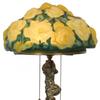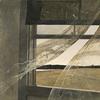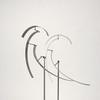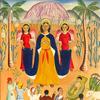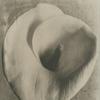First comprehensive U.S. museum exhibition on legendary Black Mountain College premieres at the Institute of Contemporary Art/Boston on Oct. 10
- BOSTON, Massachusetts
- /
- June 15, 2015
This October, the Institute of Contemporary Art/Boston (ICA) opens the first comprehensive U.S. museum exhibition on Black Mountain College (BMC), a small, experimental school in North Carolina whose influence on art practice and pedagogy still has profound impact today. Leap Before You Look: Black Mountain College 1933–1957 focuses on how, despite its brief existence, Black Mountain College became a seminal meeting place for many of the artists, musicians, poets, and thinkers who would become leading practitioners of the postwar period. Figures such as Anni and Josef Albers, John Cage, Merce Cunningham, Robert Rauschenberg, Elaine and Willem de Kooning, Buckminster Fuller, Ruth Asawa, Robert Motherwell, Gwendolyn and Jacob Lawrence, Cy Twombly, Franz Kline, Charles Olson, and Robert Creeley taught and studied at the college, among many others.
The exhibition features 261 objects by nearly 100 artists, archival materials, and, true to the interdisciplinary nature of the school, a grand piano and dance floor for live, in-gallery performances. Organized by Helen Molesworth, the ICA’s former Barbara Lee Chief Curator, with Assistant Curator Ruth Erickson, Leap Before You Look will be on view from Oct. 10, 2015 to Jan. 24, 2016. Following its ICA debut, the exhibition will travel to the Armand Hammer Museum in Los Angeles, California (Feb. 21–May 14, 2016) and the Wexner Center for the Arts in Columbus, Ohio (Sept. 17, 2016–Jan. 1, 2017.)
“We are extremely proud to present Leap Before You Look: Black Mountain College 1933-1957, a comprehensive examination of Black Mountain College, whose radical art, artists, and ideas have had a lasting impact on the art of our time,” said Jill Medvedow, Ellen Matilda Poss Director. “The most ambitious curatorial project ever undertaken by the ICA, the exhibition and performances pose an expansive vision of the arts and creativity—one that matches the ICA’s interdisciplinary artistic program and our view of the centrality of the arts in education.”
“Black Mountain College is an important historical precedent for thinking about relationships between art, pedagogy, democracy, and globalism,” said Molesworth. “Leap Before You Look examines the college’s critical role in shaping many major movements, and ideas in postwar art and education, including assemblage, contemporary dance and music, the New American Poetry, and the American studio craft movement—influences that can still be seen and felt today.”
The exhibition follows a gentle chronology, organizing the material in thematic sections, allowing each gallery to elucidate various aspects of BMC’s practice, pedagogy, and philosophy.
An introductory gallery offers background into the origins of Black Mountain College, founded in 1933 by John Rice. Influenced by the utopian ideals of the progressive education movement, BMC placed the arts at the center of a liberal arts education and believed that in doing so it could better educate citizens for participation in a democratic society. A 1952 college bulletin stated: “Our central and consistent effort is to teach method, not content; to emphasize process, to invite the student to the realization that the way of handling facts and himself amid the facts is more important than the facts themselves.”
The exhibition subsequently focuses on Anni and Josef Albers. Josef Albers was hired from the Bauhaus in Nazi-era Germany to become BMC’s first art faculty. Given the centrality of his pedagogy, and Anni’s writing and weaving, to the BMC experience, this room is dedicated to their work, including prints, paintings, photographs, and weavings made by the Alberses during their tenure at the college from 1933 to 1949. One highlight is the many trips the Alberses took to Mexico while they were at BMC and the impact these visits had on their work and teaching. Included are Anni Albers’s Monte Alban (1936), a large-scale weaving in which the strict geometry of the grid is combined with the wandering outline of Zapotec architecture, and Josef Albers’s Tenayuca (1943), an abstract painting inspired by the stairways and platforms of the eponymous Aztec pyramid.
Viewers are introduced to BMC pedagogies, which all shared the ideal of “learning through doing.” The exhibition contains work and photographs from Josef Albers’s courses in design, drawing, color, and material studies. Also exhibited are the collaborative work of students and teachers, such as jewelry made by student Alexander Reed with Anni Albers using every day materials such as corks, paper clips, and bobby pins. Models and studies for Buckminster Fuller’s geodesic sphere, first erected at BMC, are included alongside an examination of the role architectural building played at the college. These didactic tools exemplified the college’s mission to teach through hands-on experimentation.
Black Mountain College was a cosmopolitan gathering place for artists from Europe, Asia, and the United States, making it a place where a wide variety of ideas and artistic practices converged. The exhibition explores the concept of cosmopolitanism as a framework for understanding the unique position of BMC as a conduit between European and American avant-gardes which profoundly shaped the development of postwar artistic practice, teaching, and identity. Works by European artists such as Xanti Schawinsky, Lyonel Feininger, Ilya Bolotowsky, and Josef Breitenbach are presented alongside paintings by a younger generation of American artists including Elaine and Willem de Kooning, Robert Motherwell, Gwendolyn and Jacob Lawrence, and Franz Kline.
While there is no such thing as a Black Mountain aesthetic, the exhibition puts forward the idea that BMC generated a rich field of art, craft, and performance with a shared interest in the tactility of materials, the process of making, and the bodily engagement of the maker. Profoundly interdisciplinary, BMC gave rise to one of the 20th-century’s most legendary artistic collaborations: that of Merce Cunningham, John Cage, and Robert Rauschenberg. The exhibition features a sprung dance floor for live dance performances (see performance section below); a grand piano that will be “prepared” according Cage’s specifications; and a freestanding set decoration by Rauschenberg titled Minutiae (originally 1957).
The final gallery focuses on the college in the 1950s, a period when poetry and pottery took on especially significant roles at BMC. In his influential essay “Projective Verse,” the poet Charles Olson (the final BMC rector from 1951 to 1957) reimagines poetry as a field of action, emphasizing the use of the entire page and the importance of breath. These ideas became a catalyst for a generation of young American poets, many of whom Olson invited to teach at BMC, including Robert Creeley and Robert Duncan. This gallery examines the college’s critical role in the development of experimental literature in the United States. At the same time, the BMC pottery shop was formed and a series of influential ceramic artists taught at BMC, including Robert Turner, Karen Karnes, and Peter Voulkos. Many of those involved with pottery at BMC would lead the modern studio pottery movement in the United States.

